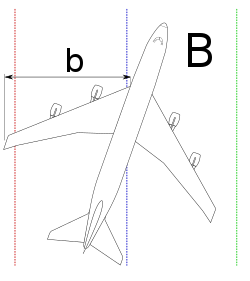Dutch roll
Dutch roll , wobble , Dutch roll or yaw oscillation describes an undesirable aerodynamic behavior of aircraft in which the machine deflects alternately on both sides around the yaw axis (vertical axis) and longitudinal axis .
Wings above the aircraft's center of gravity and a positive V-position of the wing increase the tendency to dutch rolls . Therefore, the wings of high and shoulder planes are often arranged in a negative V-position. The "Dutch roll" problem can be found on all aircraft with swept wings .
Since Dutch Rolls are generally undesirable, were as a countermeasure yaw damper (Engl. Yaw damper ) developed. These are systems that counteract unwanted yaw movements by deflecting the rudder.
Explanation

Dutch Roll is a coupling of vibrations around the vertical and longitudinal axes. The tendency towards Dutch Roll arises when the influence of lateral stability is greater than that of course stability. If an aircraft is disturbed in its course equilibrium, the leading surface creates more lift and more drag than the trailing surface. The effect of the buoyancy greater than that of the resistor, then a Sideslip maneuver ( sideslip ) in the opposite direction and the Dutch roll cycle repeats.
The Dutch roll problem is found on all swept wing aircraft. That is why most aircraft are equipped with a yaw damper. The effect of the Dutch roll problem can be partially mitigated by decreasing the arrow angle and improving course stability. The rate stability can be achieved by using larger rudder units are improved, which, however, detrimental to size, weight, structure and drag effect. An extension of the aircraft fuselage, in particular the extension of the distance between the vertical stabilizer and the aerodynamic center of gravity, extends the lever arm and thus increases the force with which the vertical stabilizer can act on the aircraft to stabilize its course (Fig. 2).
Naming
The term Dutch Roll comes from English and literally means "Dutch roll".
There are two interpretations of the origin of the name.
Most often it is reported that the name goes back to the association with Dutch skaters who made a movement on the ice similar to the yaw vibration of an airplane. This interpretation is often attributed to an engineer who is not named and who was involved in the development of the Boeing B-47 . This type of aircraft, launched in 1947, was one of the first to reach the critical speed range in which Dutch Rolls occur.
Another interpretation refers to the English expression Dutch courage (literally: Dutch courage ) for intoxicated courage . She alludes to the fact that these pendulum movements give an airplane the impression that it is being steered under the influence of alcohol.
See also
Web links
- Thread on naming at pprune.org (English)



